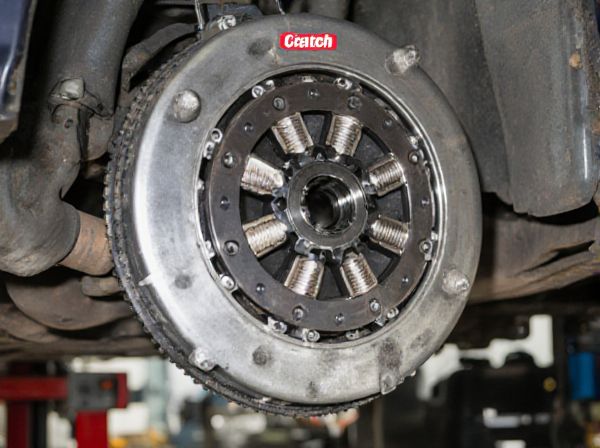
Photo illustration: Self-Adjusting Clutch vs Standard Clutch
A self-adjusting clutch automatically maintains optimal pedal free play and consistent engagement, reducing the need for frequent manual adjustments and enhancing driving comfort. Standard clutches require periodic manual adjustments to compensate for wear, which can lead to inconsistent pedal feel and potential clutch slippage. Choosing a self-adjusting clutch ensures smoother operation and longer component lifespan, benefiting your vehicle's overall performance.
Table of Comparison
| Feature | Self-Adjusting Clutch | Standard Clutch |
|---|---|---|
| Adjustment | Automatic, maintains optimal pedal free play | Manual, requires periodic adjustment |
| Maintenance | Low, fewer adjustments needed | Higher, frequent adjustments required |
| Lifespan | Extended due to consistent performance | Variable, depends on manual adjustment quality |
| Cost | Higher initial cost | Lower initial cost |
| Performance | Consistent clutch engagement and pedal feel | Can degrade if not properly adjusted |
| Suitability | Ideal for high-mileage and heavy usage | Suitable for casual or low-mileage drivers |
Introduction to Clutches: Self-Adjusting vs Standard
Self-adjusting clutches automatically maintain optimal pedal free play by compensating for wear, enhancing driving comfort and reducing maintenance frequency. Standard clutches require manual adjustment to preserve proper engagement and prevent slippage as friction material wears, necessitating more frequent inspections. Choosing between self-adjusting and standard clutches impacts vehicle performance, reliability, and overall driving experience based on ease of maintenance and longevity.
How a Standard Clutch Works
A standard clutch operates by engaging and disengaging the engine flywheel and transmission to facilitate gear changes. When the clutch pedal is pressed, the pressure plate releases the clutch disc, disconnecting the engine power from the transmission, allowing smooth shifting. This manual adjustment requires periodic maintenance to ensure proper clutch disengagement and prevent slippage due to wear or cable/stretch in the linkage.
How a Self-Adjusting Clutch Functions
A self-adjusting clutch operates by automatically compensating for clutch wear, maintaining consistent pedal feel and engagement throughout its lifespan. It uses a spring mechanism or a wear compensator to adjust the clearance between the clutch disc and pressure plate, ensuring optimal contact without manual intervention. This functionality reduces the need for frequent clutch adjustments compared to a standard clutch system, improving driving comfort and extending component durability.
Key Differences Between Self-Adjusting and Standard Clutches
Self-adjusting clutches automatically maintain optimal pedal free play by compensating for clutch wear, ensuring consistent performance and reducing the need for manual adjustments. Standard clutches require periodic manual adjustment to preserve proper engagement and pedal feel, which can lead to inconsistent performance if neglected. The self-adjusting mechanism enhances driving comfort and prolongs clutch lifespan by adapting to wear in real-time.
Advantages of Self-Adjusting Clutches
Self-adjusting clutches maintain optimal pedal free play by automatically compensating for clutch wear, ensuring consistent performance and reducing the need for manual adjustments. These clutches enhance driving comfort and prolong clutch lifespan by preventing slipping and promoting smoother engagement. Their maintenance efficiency and reliability make them superior to standard clutches, saving time and reducing repair costs.
Benefits of Standard Clutch Systems
Standard clutch systems offer straightforward design, ensuring easy maintenance and reliable performance in a wide range of vehicles. Their mechanical simplicity reduces repair costs and downtime, making them ideal for cost-conscious users and routine driving conditions. Standard clutches provide consistent pedal feel and predictable engagement, enhancing driver control and confidence.
Common Issues in Self-Adjusting Clutches
Self-adjusting clutches often experience issues such as uneven wear of clutch components, resulting in inconsistent pedal feel and engagement. The automatic adjustment mechanism can sometimes fail or become sluggish, leading to improper clutch bite point and reduced drivability. Frequent exposure to heat and friction may cause premature wear in self-adjusting clutch systems compared to standard clutches, necessitating more frequent maintenance or replacement.
Maintenance Requirements: Self-Adjusting vs Standard Clutch
Self-adjusting clutches require significantly less maintenance than standard clutches due to their ability to automatically compensate for clutch wear, eliminating the need for regular manual adjustments. Standard clutches demand frequent inspections and manual adjustments to maintain optimal performance and prevent premature wear, increasing labor time and costs. The automatic adjustment mechanism in self-adjusting clutches enhances durability and reliability, reducing downtime and overall maintenance expenses.
Cost Comparison: Self-Adjusting Clutch vs Standard Clutch
Self-adjusting clutches typically have a higher upfront cost compared to standard clutches due to their advanced mechanism that automatically compensates for wear, reducing maintenance needs over time. Standard clutches are generally more affordable initially but may incur additional expenses for manual adjustments and more frequent replacements. When evaluating long-term cost-effectiveness, self-adjusting clutches offer savings by minimizing downtime and maintenance labor expenses.
Choosing the Right Clutch for Your Vehicle
When choosing the right clutch for your vehicle, consider a self-adjusting clutch for its ability to maintain optimal pedal feel and engagement over time, reducing the need for manual adjustments. Standard clutches typically require periodic maintenance to compensate for wear, which can lead to inconsistent performance and added service intervals. Evaluating your driving style, vehicle usage, and maintenance preferences helps determine if the convenience of a self-adjusting clutch outweighs the lower initial cost of a standard clutch.
 caratoz.com
caratoz.com